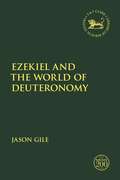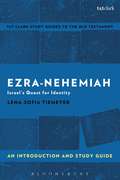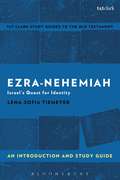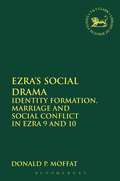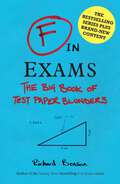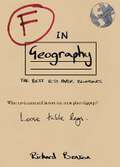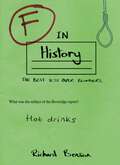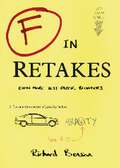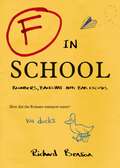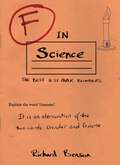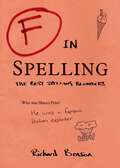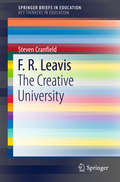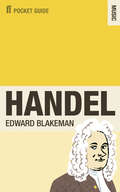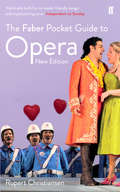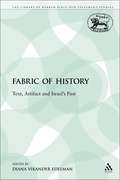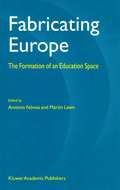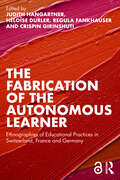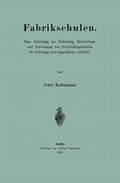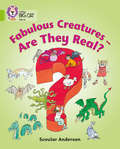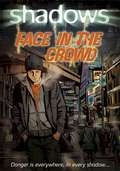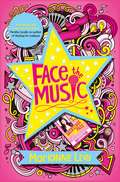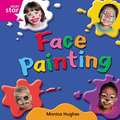- Table View
- List View
Ezekiel and the World of Deuteronomy (The Library of Hebrew Bible/Old Testament Studies)
by Jason GileJason Gile argues that the ideas of Deuteronomy influenced Ezekiel's response to the crisis surrounding the fall of Jerusalem and the Babylonian exile in significant ways, shaping how he saw Israel's past history of rebellion against Yahweh, present situation of divine judgment, and future hope of restoration. By examining Ezekiel's use of Deuteronomy's language and concepts, Giles stresses that the prophet not only accepted distinctive elements of Deuteronomic theology but in some cases drew from specific texts. The main body of this volume describes Deuteronomy's influence on Ezekiel under five main categories: Ezekiel's language and conception of idolatry, the rise and fall of Israel in chapter 16, Ezekiel's view of Israel's history in chapter 20, the scattering of Israel as an image for exile, and the related motif of gathering as an image for return to the land. Gile concludes that Ezekiel's use of its language for his messages of indictment, judgment, and hope shows that the prophet regarded Deuteronomy, along with the Holiness Code, as Yahweh's torah given to Israel in the wilderness.
Ezra-Nehemiah: Israel's Quest for Identity (T&T Clark’s Study Guides to the Old Testament)
by Dr Lena-Sofia TiemeyerThis guide to Ezra and Nehemiah showcases the latest developments and most up-to-date scholarship on these important texts. Ezra and Nehemiah tell the story of the people in Yehud in the 6th and the 5th centuries BCE. This was a time of economic hardship. The people living in and around Jerusalem were scratching out a living in a land that had been devastated by war. It was also a time of soul searching. Having lost their political autonomy and national identity, the people in Yehud had to find new ways of understanding and shaping their identity. Ezra and Nehemiah provide glimpses of these issues by way of an assortment of narratives, lists, letters, and other types of records. The readers encounter different voices and different opinions. Lena-Sofia Tiemeyer provides an overview of the various texts and the topics, concerns, and disputes that they reflect. The guide also zooms in on select key issues pertaining to the development of the text, its historical background(s), the quest for identity, and its afterlife in Jewish and Christian traditions.
Ezra-Nehemiah: Israel's Quest for Identity (T&T Clark’s Study Guides to the Old Testament)
by Lena-Sofia TiemeyerThis guide to Ezra and Nehemiah showcases the latest developments and most up-to-date scholarship on these important texts. Ezra and Nehemiah tell the story of the people in Yehud in the 6th and the 5th centuries BCE. This was a time of economic hardship. The people living in and around Jerusalem were scratching out a living in a land that had been devastated by war. It was also a time of soul searching. Having lost their political autonomy and national identity, the people in Yehud had to find new ways of understanding and shaping their identity. Ezra and Nehemiah provide glimpses of these issues by way of an assortment of narratives, lists, letters, and other types of records. The readers encounter different voices and different opinions. Lena-Sofia Tiemeyer provides an overview of the various texts and the topics, concerns, and disputes that they reflect. The guide also zooms in on select key issues pertaining to the development of the text, its historical background(s), the quest for identity, and its afterlife in Jewish and Christian traditions.
Ezra's Social Drama: Identity Formation, Marriage and Social Conflict in Ezra 9 and 10 (The Library of Hebrew Bible/Old Testament Studies)
by Donald P. MoffatMoffat aims to provide further insight into the mixedmarriage narrative by exposing the social and cultural factors on which it isbased. He also identifies historical traces in the narrative that cancontribute to a historical reconstruction of the post-exilic era.The socio-cultural analysis highlights previously unobservedaspects of the narrative as it understands that the narrative reflects acontext in which identity formation issues were prominent in Persian Yehud.Moffat argues that the rituals of mourning and penitential prayer are importantacts that shaped the mixed marriage controversy. The label 'foreign women' isidentified as a symbol which carried considerable freight and connected themixed marriages with wider social discourse on identity. Further, the Exodustraditions are shown to be significant for the conceptual foundationsunderlying the narrative and the society that produced it. The analysis alsogives reason to understand Ezra as the pivotal character in narrative plot. Thisnot only affects how the narrative is understood but has implications forhistorical reconstruction that utilises this narrative.
F in Exams: The Big Book of Test Paper Blunders
by Richard BensonBursting with head-scratching exam answers, this collection brings together the most side-splitting examples from the F in Exams series.
F in Geography (F In Exams Ser.)
by Richard BensonIf you get perspiration and precipitation confused, then take comfort in this hilarious, all-new, fun-size dose of F in Exams, containing some of the most cringeworthy howlers from school Geography exams.
F in History (F In Exams Ser.)
by Richard BensonIf you don’t know a cold war from a cold sore, then take comfort in this cracking, all-new, fun-size dose of F in Exams, containing some of the worst howlers from school history exams.
F in Retakes: Even More Test Paper Blunders (F In Exams Ser.)
by Richard BensonThe F in Exams are over, the results are in and just when you thought it was safe to go back in the classroom… BANG! It’s time for F in Retakes! Enjoy another heady dose of hilarious answers that canny students have given to the trickiest exam questions.
F in School: Blunders, Backchat and Bad Excuses (F In Exams Ser.)
by Richard BensonAhh, glorious school days… It’s no wonder they went so quickly with all the exams, the classroom fun, the sticky situations to get out of, the work to avoid and the teachers to annoy. Enjoy this new collection of hilarious exam answers, along with schoolyard jokes, amusing doodles, silly excuses, spelling slip-ups and loads more!
F in Science (F In Exams Ser.)
by Richard BensonIf the thought of science exams conjures up the memory of singeing your eyebrow on a Bunsen burner, then take comfort in this cracking, all-new, funsize dose of F in Exams, containing some of the most glorious howlers from school science exams.
F in Spelling: The Funniest Test Paper Blunders (F In Exams Ser.)
by Richard BensonWe all know that the written word is full of traps for the unwary, and this goes double for those in their early years of learning it. Enjoy this collection of side-splitting spelling slip-ups ranging from the charming to the ridiculous, and the cute to the unintentionally X-rated!
F. R. Leavis: The Creative University (SpringerBriefs in Education)
by Steven CranfieldThis is a critical introduction to the educational thought of F. R. Leavis (1895–1978), the greatest English literary critic of the twentieth century, providing the first in-depth examination of Leavis’s ideas in relation to contemporary mass higher education. During the course of a long, prolific and controversial academic career, which saw him take issue with figures such as Wittgenstein, T. S. Eliot and C. P. Snow, Leavis became one of the most articulate advocates for the idea of the university as ‘a centre of consciousness and human responsibility’ in the face of what he saw as the relentless technological drive of civilisation. With the journal Scrutiny which he co-founded, as well as his critical writings, Leavis became a decisive influence on generations of teachers in Britain and overseas. Widely misrepresented as narrowly elitist, his ideas about ‘the creative university’, with their radical, student-centred approach to teaching, constitute a powerful resource for a higher education system grappling with the contradictory demands of continuity and change. Based on original research, the study provides an overview of Leavis’s life, work and heritage and his educational world view, and a comprehensive exploration of Leavis’s pedagogy from theoretical and practical perspectives. It also includes a first-hand account by the author of being taught by Leavis in person.
The Faber Pocket Guide to Handel
by Edward BlakemanThe Faber Pocket Guide to Handel offers a detailed but accessible exploration of George Frederick Handel, his composition, and his legacy. A larger-than-life figure in his time, Handel's reputation has been less than steady since his death in 1759. Was he (in the words of Berlioz) just 'a great barrel of pork and beer', or (as Handel himself claimed) truly 'the master of us all'? Now, more than 250 years after his death, there is more interest in Handel than ever before, with his operas (such as Rinaldo and Agrippina) experiencing fantastic renewed popularity. This lively new Pocket Guide goes in search of the composer who wrote the Messiah, Water Music - and much more.Handy for browsing and reference, key features include:- Handel's life: year by year- Handel's operas: a complete guide- Essential Handel- Picturing Handel- Handel on CD and DVD- Handel OnlineEdward Blakeman assesses how Handel's works - incredibly influential in their context of baroque music - have stood the test of time and why they can still speak thrillingly to us today. With recommendations throughout for listening, further reading, and web surfing, this is the ideal guide for music lovers who want to discover the great composer for themselves.
The Faber Pocket Guide to Opera: New Edition
by Rupert ChristiansenThis new edition of leading opera critic Rupert Christiansen's perennially popular Pocket Guide has between extensively revised, and incorporates many more operas from all periods, including recent works by Philip Glass, Mark Anthony Turnage, Thomas Adès and George Benjamin. Whether you are a first-timer at La Boheme or a seasoned Wagnerian, every opera-goer can benefit from a little background information, and this book aims to provide just that. Accessible and easy-to-use, it contains entries for over a hundred works, both familiar and unfamiliar.
The Fabric of History: Text, Artifact and Israel's Past (The Library of Hebrew Bible/Old Testament Studies)
by Diana Vikander EdelmanSix scholars explore the nature of history and historical reconstruction and the place of history within biblical studies. The uncritical use of both text and artifact that continues to dominate histories of Israel and Judah testifies to the need for a wider grassroots awareness of the basic issues involved in doing history as a biblical scholar. A growing number of scholars are questioning the theoretical underpinnings of the main 'schools' of research and are calling for an approach that makes a more critical evaluation of both textual and artifactual material before using it in historical reconstruction. These essays were first presented at the annual SBL/ASOR meeting in 1989 in a symposium entitled 'The Role of History and Archaeology in Biblical Studies'.
Fabricating Europe: The Formation of an Education Space
by António Nóvoa M. LawnFabricating Europe has within it a core idea, a crucial but imprecise idea, that of a European educational space, which transnational governance, networks and cultural and economic projects are creating now. Yet, the perceptible creation of this contemporary space of European policy making and networking has not been a subject of study. It appears offstage in studies of national systems in which national and professional identity; political organization; policy formation and public/private markets are all viewed as contained within the borders of the state.Fabricating Europe is concerned with the new possibilities to be discerned and imagined in the European public and institutional spaces and discourses in education and the lack of impetus within the broad area of educational studies to meet the task of creating analyses and responses.
The Fabrication of the Autonomous Learner: Ethnographies of Educational Practices in Switzerland, France and Germany
by Judith Hangartner Héloïse Durler Regula Fankhauser Crispin GirinshutiThis book provides a thorough and detailed analysis of how the figure of the ‘autonomous learner’ shapes educational practices. It unpacks the impact of current educational reform discourse that focuses on the individual pupil as a learner, while neglecting the social dimensions of classroom practices. In view of the yet unknown requirements of the knowledge economy, students are demanded to take more responsibility for their learning and to become self-reliant, independent, lifelong learners. In turn, teachers are asked to tailor education to the individual needs of their students and to foster their individual learning trajectories. Based on in-depth fieldwork and long-term observation of interactions in classrooms and other scholastic settings, scholars from three European countries – France, Germany and Switzerland – show how the translation of the figure of the ‘autonomous learner’ into classrooms is shaped by distinct cultural traditions. Chapters analyse teaching routines and conceptions of self-reliance involved in autonomy-oriented settings and discuss how these change the sociality of the classroom. They scrutinize how autonomy is used to differentiate between students and how it contributes to the reproduction of social inequality. The book brings into dialogue two neighbouring research traditions that research autonomous learning from a sociological perspective and which have largely ignored each other until now. In so doing, the contributions engage a critical perspective for a careful empirical analysis in order to better understand what is being done in the name of autonomy. Providing insight into the many facets of developing and nurturing self-standing pupils across various educational contexts, this is ideal reading for scholars in the field of education, as well as teachers and decision-makers across the educational sector.
The Fabrication of the Autonomous Learner: Ethnographies of Educational Practices in Switzerland, France and Germany
This book provides a thorough and detailed analysis of how the figure of the ‘autonomous learner’ shapes educational practices. It unpacks the impact of current educational reform discourse that focuses on the individual pupil as a learner, while neglecting the social dimensions of classroom practices. In view of the yet unknown requirements of the knowledge economy, students are demanded to take more responsibility for their learning and to become self-reliant, independent, lifelong learners. In turn, teachers are asked to tailor education to the individual needs of their students and to foster their individual learning trajectories. Based on in-depth fieldwork and long-term observation of interactions in classrooms and other scholastic settings, scholars from three European countries – France, Germany and Switzerland – show how the translation of the figure of the ‘autonomous learner’ into classrooms is shaped by distinct cultural traditions. Chapters analyse teaching routines and conceptions of self-reliance involved in autonomy-oriented settings and discuss how these change the sociality of the classroom. They scrutinize how autonomy is used to differentiate between students and how it contributes to the reproduction of social inequality. The book brings into dialogue two neighbouring research traditions that research autonomous learning from a sociological perspective and which have largely ignored each other until now. In so doing, the contributions engage a critical perspective for a careful empirical analysis in order to better understand what is being done in the name of autonomy. Providing insight into the many facets of developing and nurturing self-standing pupils across various educational contexts, this is ideal reading for scholars in the field of education, as well as teachers and decision-makers across the educational sector.
Fabrikschulen: Eine Anleitung zur Gründung, Einrichtung und Verwaltung von Fortbildungsschulen für Lehrlinge und jugendliche Arbeiter
by Curt KohlmannDieser Buchtitel ist Teil des Digitalisierungsprojekts Springer Book Archives mit Publikationen, die seit den Anfängen des Verlags von 1842 erschienen sind. Der Verlag stellt mit diesem Archiv Quellen für die historische wie auch die disziplingeschichtliche Forschung zur Verfügung, die jeweils im historischen Kontext betrachtet werden müssen. Dieser Titel erschien in der Zeit vor 1945 und wird daher in seiner zeittypischen politisch-ideologischen Ausrichtung vom Verlag nicht beworben.
Fabulous Creatures – Are they Real?: Band 11/lime (Collins Big Cat)
by Scoular AndersonThis witty information book describes real and imaginary creatures, and answers the question – are they real? Some of the creatures are from myths and legends, while others are genuine. Included are the Loch Ness Monster, about which there is disagreement, the vampire bat, and the yeti.
Face in the Crowd (Shadows)
by Paul BlumMatt Merton sees his missing girlfriend on a busy street. He follows her to a house full of strange women. Has he found Jane at last? Part of the Shadows series for less able readers, this book is set in the near future, where an alien invasion has left the Earth devastated and a mysterious organisation called The Firm hold power.
Face in the Crowd (Shadows)
by Paul BlumMatt Merton sees his missing girlfriend on a busy street. He follows her to a house full of strange women. Has he found Jane at last? Part of the Shadows series for less able readers, this book is set in the near future, where an alien invasion has left the Earth devastated and a mysterious organisation called The Firm hold power.
Face The Music
by Marianne LevyKatie Cox (overnight singing sensation and owner of the World’s Wonkiest Fringe) never meant to become a pop star. And she didn’t mean to start a war with Karamel (aka the World’s Cheesiest Boy Band).Now her first concert is just days away. Cool? Maybe. Terrifying? Definitely. And with her school friends more interested in her fame than her feelings, and an army of Karamel fans ready to take her down, this battle goes way beyond the charts.
Face Painting (Rigby Star Independent #Pink Reader 10)
by Monica HughesHow will you get your face painted? Designed to offer links from guided to independent reading. It is linked to guided reading objectives, allowing children to practise valuable skills following a guided reading session. The titles are levelled to Book Bands for Guided Reading, and provide stories that children are able to read independently. Each title contains reading notes written specifically for parents/Learning Support Assistants. These focus on key reading skills and encourage discussion to improve children's comprehension. The Pink Level titles are aimed at children in Reception.
Face Painting (Rigby Star Independent #Pink Reader 10)
by Monica HughesHow will you get your face painted? Designed to offer links from guided to independent reading. It is linked to guided reading objectives, allowing children to practise valuable skills following a guided reading session. The titles are levelled to Book Bands for Guided Reading, and provide stories that children are able to read independently. Each title contains reading notes written specifically for parents/Learning Support Assistants. These focus on key reading skills and encourage discussion to improve children's comprehension. The Pink Level titles are aimed at children in Reception.
